 |
|
 |
|
Top Ten Most Popular Travel Attraction Destinations in China
China, the third largest country in the world, offers an endless variety of fulfilling and interesting attraction destinations, including modern cities, hundreds of ancinet relic sites; countless museums; beautiful and interesting caves, gardens, grottos, lakes, mountains, rivers and waterfalls, as well as timeless monasteries, temples and villages.
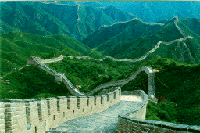 1- The Great Wall of China was built over 2,000 years ago, by the first emperor of China during the Qin (Ch'in) Dynasty (221 B.C - 206 B.C.). In Chinese the wall is called "Wan-Li Qang-Qeng" which means 10,000-Li Long Wall. During the Ming Dynasty (1368-1644), the Great Wall was enlarged to 6,400 kilometers (4,000 miles) and renovated over a 200 year period, with watch-towers and cannons added. It stretches across the mountains of northern China, from the Jiayu Pass (in Gansu Province) in the west, to the mouth of the Yalu River (in Liaoning Province) in the east. The Great Wall can be seen from Earth orbit, but, contrary to legend, is not visible from the moon, according to astronauts Neil Armstrong, Jim Lovell, and Jim Irwin 1- The Great Wall of China was built over 2,000 years ago, by the first emperor of China during the Qin (Ch'in) Dynasty (221 B.C - 206 B.C.). In Chinese the wall is called "Wan-Li Qang-Qeng" which means 10,000-Li Long Wall. During the Ming Dynasty (1368-1644), the Great Wall was enlarged to 6,400 kilometers (4,000 miles) and renovated over a 200 year period, with watch-towers and cannons added. It stretches across the mountains of northern China, from the Jiayu Pass (in Gansu Province) in the west, to the mouth of the Yalu River (in Liaoning Province) in the east. The Great Wall can be seen from Earth orbit, but, contrary to legend, is not visible from the moon, according to astronauts Neil Armstrong, Jim Lovell, and Jim Irwin
|
|
 2- The Forbidden City is the largest, best-preserved, Mass group of palaces in China and is located in the middle of Beijing, China. It is now known as The Palace Museum. It was once the Chinese imperial palace during the mid-Ming and the Qing Dynasties. Tradition has it that there are altogether 9999.5 rooms in the Forbidden City, only half room less than the Heavenly Palace, which belongs to the Jade Emperor in the heaven. So it is said that the Forbidden City is the largest palace in the world. Immediately to the north of the Palace Museum is Prospect Hill (also called Coal Hill), while on the east and west are Wangfujing and Zhongnanhai neighborhoods. It is a location endowed with cosmic significance by ancient China's astronomers. Correlating the emperor's abode, which they considered the pivot of the terrestrial world, with the Pole Star (Ziweiyuan), which they believed to be at the center of the heavens, they called the palace The Purple Forbidden City. 2- The Forbidden City is the largest, best-preserved, Mass group of palaces in China and is located in the middle of Beijing, China. It is now known as The Palace Museum. It was once the Chinese imperial palace during the mid-Ming and the Qing Dynasties. Tradition has it that there are altogether 9999.5 rooms in the Forbidden City, only half room less than the Heavenly Palace, which belongs to the Jade Emperor in the heaven. So it is said that the Forbidden City is the largest palace in the world. Immediately to the north of the Palace Museum is Prospect Hill (also called Coal Hill), while on the east and west are Wangfujing and Zhongnanhai neighborhoods. It is a location endowed with cosmic significance by ancient China's astronomers. Correlating the emperor's abode, which they considered the pivot of the terrestrial world, with the Pole Star (Ziweiyuan), which they believed to be at the center of the heavens, they called the palace The Purple Forbidden City.
|
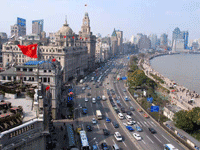 3- The Bund Area (Wai Tan) located along the Huangpu River many foreign businesses snatched the prime area in Shanghai, to establish concessions, banks, headquarters, and consul houses earning the reputation of "The Oriental Wall Street". Even today, visitors can still feel the prosperity of the old Shanghai, when looking at those old buildings. “The Bund” was derived from the Anglo-Indian term that literally means “a muddy embankment.” At the beginning of the 19th century, the area was a mere shallow waterfront covered with reeds. At the northwestern end of the Bund was Huangpu Park (once called British Public Gardens). More of a pedestrian walkway than a conventional park, this area was also under the control of the Brits. It was forbidden territory to Chinese people for years, unless they were accompanying employers. Today, the park is free and open to everyone; it is a well-maintained walkway providing excellent views over the river to Pudong and down the river to the old Customs House and other colonial relics. 3- The Bund Area (Wai Tan) located along the Huangpu River many foreign businesses snatched the prime area in Shanghai, to establish concessions, banks, headquarters, and consul houses earning the reputation of "The Oriental Wall Street". Even today, visitors can still feel the prosperity of the old Shanghai, when looking at those old buildings. “The Bund” was derived from the Anglo-Indian term that literally means “a muddy embankment.” At the beginning of the 19th century, the area was a mere shallow waterfront covered with reeds. At the northwestern end of the Bund was Huangpu Park (once called British Public Gardens). More of a pedestrian walkway than a conventional park, this area was also under the control of the Brits. It was forbidden territory to Chinese people for years, unless they were accompanying employers. Today, the park is free and open to everyone; it is a well-maintained walkway providing excellent views over the river to Pudong and down the river to the old Customs House and other colonial relics.
|
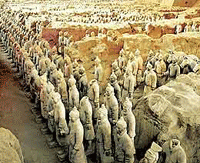 4- Terracotta Warriors and Horses of Qin Shi Huang soon stirred up a sensation all over the world. It was listed as a wonder of ancient times and one of the most significant contemporary archeological excavations in the world. Visitors are amazed at the gigantic scale, marvelous scenery and lofty artistic and scientific achievements displayed in the Terracotta Warriors exhibit.Work is ongoing at this site, which is around 1.5 kilometers east of Emperor Qin Shi Huang's Mausoleum, Lintong County, Shaanxi province. It is a sight not to be missed by any visitor to China. Upon ascending the throne at the age of 13 (in 246 BC), Qin Shi Huang, later the first Emperor of all China, had begun to work for his mausoleum. It took 11 years to finish. It is speculated that many buried treasures and sacrificial objects had accompanied the emperor in his after life. A group of peasants uncovered some pottery while digging for a well nearby the royal tomb in 1974. Altogether over 7,000 pottery soldiers, horses, chariots, and even weapons have been unearthed from these pits. Most of them have been restored to their former grandeur. 4- Terracotta Warriors and Horses of Qin Shi Huang soon stirred up a sensation all over the world. It was listed as a wonder of ancient times and one of the most significant contemporary archeological excavations in the world. Visitors are amazed at the gigantic scale, marvelous scenery and lofty artistic and scientific achievements displayed in the Terracotta Warriors exhibit.Work is ongoing at this site, which is around 1.5 kilometers east of Emperor Qin Shi Huang's Mausoleum, Lintong County, Shaanxi province. It is a sight not to be missed by any visitor to China. Upon ascending the throne at the age of 13 (in 246 BC), Qin Shi Huang, later the first Emperor of all China, had begun to work for his mausoleum. It took 11 years to finish. It is speculated that many buried treasures and sacrificial objects had accompanied the emperor in his after life. A group of peasants uncovered some pottery while digging for a well nearby the royal tomb in 1974. Altogether over 7,000 pottery soldiers, horses, chariots, and even weapons have been unearthed from these pits. Most of them have been restored to their former grandeur.
|
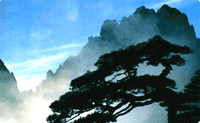 5- Mount Huangshan or Yellow Mountain ranks among the Great Wall and the famous Terracotta Warriors as one of China’s most luring tourist attractions. Located in the eastern province of Anhui, it is a convenient train or bus ride from urban centers like Hangzhou and Shanghai—a perfect getaway for visitors in search of fresh air and a chance to experience China’s natural beauty. The landform of Yellow Mountain is a kind of typical granite mountains and forests. It was the result of several movements of lithosphere as well as the work of nature during the long geological age. 77 peaks are more than 1,000 metres above sea level. Granite limestone towers and oddly-shaped rocks spread all over the scenic area. 5- Mount Huangshan or Yellow Mountain ranks among the Great Wall and the famous Terracotta Warriors as one of China’s most luring tourist attractions. Located in the eastern province of Anhui, it is a convenient train or bus ride from urban centers like Hangzhou and Shanghai—a perfect getaway for visitors in search of fresh air and a chance to experience China’s natural beauty. The landform of Yellow Mountain is a kind of typical granite mountains and forests. It was the result of several movements of lithosphere as well as the work of nature during the long geological age. 77 peaks are more than 1,000 metres above sea level. Granite limestone towers and oddly-shaped rocks spread all over the scenic area.
|
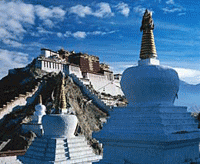 6- The Potala Palace is an ancient architectural complex considered a model of Tibetan architecture located on the Red Hill in Lhasa. The stone-and-wood-structured Potala Palace consists of the White Palace and Red Palace. The White Palace, comprising halls, temples and courtyards, serves as the living quarters of the Dalai Lama. The Red Palace includes various chambers for worshipping Buddha and chambers housing the eight stupa that contain the remains of fifth through thirteenth Dalai Lama. It is 3,700 meters above sea level and covers an area of over 360,000 square meters, measuring 360 meters from east to west and 270 meters from south to north. The palace has 13 stories, and is 117 meters high. In 641, Songtsan Gambo, ruler of the Tubo Kingdom, had the Potala Palace built for Princess Wencheng of the Tang Dynasty, whom he was soon to marry. This structure was later burned to the ground during a war and was rebuilt in the 17th century by the Fifth Dalai Lama. Repeated repairs and expansions until 1645 finally brought the palace to its present scale. 6- The Potala Palace is an ancient architectural complex considered a model of Tibetan architecture located on the Red Hill in Lhasa. The stone-and-wood-structured Potala Palace consists of the White Palace and Red Palace. The White Palace, comprising halls, temples and courtyards, serves as the living quarters of the Dalai Lama. The Red Palace includes various chambers for worshipping Buddha and chambers housing the eight stupa that contain the remains of fifth through thirteenth Dalai Lama. It is 3,700 meters above sea level and covers an area of over 360,000 square meters, measuring 360 meters from east to west and 270 meters from south to north. The palace has 13 stories, and is 117 meters high. In 641, Songtsan Gambo, ruler of the Tubo Kingdom, had the Potala Palace built for Princess Wencheng of the Tang Dynasty, whom he was soon to marry. This structure was later burned to the ground during a war and was rebuilt in the 17th century by the Fifth Dalai Lama. Repeated repairs and expansions until 1645 finally brought the palace to its present scale.
|
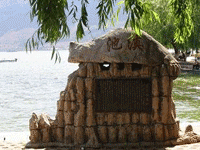 7-Dianchi Lake known as the Pearl of the Plateau is located at the foot of the Western Hills to the southwest of Kunming. The west side of Dianchi Lake is the mountain forest, while on the east side are lands dotted with the fisheries and agribusinesses. Traditional fishing boats still sail on the lake, hooking and netting. Taking a boat to voyage between the blue sky and the green water, breathing the fresh air and viewing the birds flying just at your side, what an enjoyable, light-hearted and free moment it is!The most beautiful view of Dianchi Lake appears at dawn and sunset, the refraction of the ethereal rays glitter on the water surface just like thousands of silver fishes swimming and playing. At night, when the breeze is fleeting over the water and the world is brimming over with hazy moonlight, Dianchi Lake lies in silence and breathes in peace like a sleeping beauty. The ocean-like Dianchi Lake is the best place to go for those people who wish to get away from the bustling city and be close to the nature. 7-Dianchi Lake known as the Pearl of the Plateau is located at the foot of the Western Hills to the southwest of Kunming. The west side of Dianchi Lake is the mountain forest, while on the east side are lands dotted with the fisheries and agribusinesses. Traditional fishing boats still sail on the lake, hooking and netting. Taking a boat to voyage between the blue sky and the green water, breathing the fresh air and viewing the birds flying just at your side, what an enjoyable, light-hearted and free moment it is!The most beautiful view of Dianchi Lake appears at dawn and sunset, the refraction of the ethereal rays glitter on the water surface just like thousands of silver fishes swimming and playing. At night, when the breeze is fleeting over the water and the world is brimming over with hazy moonlight, Dianchi Lake lies in silence and breathes in peace like a sleeping beauty. The ocean-like Dianchi Lake is the best place to go for those people who wish to get away from the bustling city and be close to the nature.
|
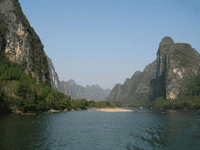 8- Li River is a bright pearl on the list of China"s tourist attractions and it is the highlight of sightseeing tour in Guilin. The 83-kilometer journey boat from Guilin down the river to Yangshuo through the numerous loft peaks of varied shapes is just like enjoying a melodious symphony. Guilin ,by the banks of the Li River , is considered to be one of the most beautiful tourist cities in China. With more than 2,000 years of cultural history, Guilin has gained reputation both at home and abroad for its unique scenery: green hills, rocky cliffs, clear water, numerous caves, stones of various shapes. Since its opening up in the early 1980s, some 70 million tourists from more than 150 countries and regions and tens of heads of foreign governments and states have toured Guilin.Double-decker and triple-decker river boats which weigh anchor from a pier at Zhujiang, by bus, and meander through the sleepy countryside are relaxing way to enjoy the superlative river scenery and life along its banks. 8- Li River is a bright pearl on the list of China"s tourist attractions and it is the highlight of sightseeing tour in Guilin. The 83-kilometer journey boat from Guilin down the river to Yangshuo through the numerous loft peaks of varied shapes is just like enjoying a melodious symphony. Guilin ,by the banks of the Li River , is considered to be one of the most beautiful tourist cities in China. With more than 2,000 years of cultural history, Guilin has gained reputation both at home and abroad for its unique scenery: green hills, rocky cliffs, clear water, numerous caves, stones of various shapes. Since its opening up in the early 1980s, some 70 million tourists from more than 150 countries and regions and tens of heads of foreign governments and states have toured Guilin.Double-decker and triple-decker river boats which weigh anchor from a pier at Zhujiang, by bus, and meander through the sleepy countryside are relaxing way to enjoy the superlative river scenery and life along its banks.
|
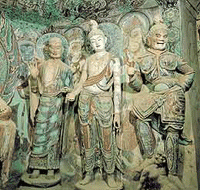 9- The Mogao Grottoes where Today, 492 caves still stand, containing some 2,100 colored statues and 45,000 square meters of murals.These murals, if joined together, would cover a length of 30 kilometers. The caves vary in size. The smallest one just allows a head's space, while the largest one stretches from the foot to the top of the mountain, having a height of over 40 meters. The colored statues also differ in size, ranging from a few centimeters to 33 meters high, embodying the remarkable imagination of their makers. Despite years of erosion, the murals are still brightly colored, with clear lines. Through pictures of different styles and schools drawn in different historical periods, they tell Buddhist stories and ways as well as life in the secular world.All these, plus a largest quantity of Buddhist sutras and relics kept in the caves have provided valuable material for a study of ancient China's politics, economy, and culture and arts, as well as its science and technology, military affairs, and religion, documenting national history as well as cultural exchanges between China and the world. 9- The Mogao Grottoes where Today, 492 caves still stand, containing some 2,100 colored statues and 45,000 square meters of murals.These murals, if joined together, would cover a length of 30 kilometers. The caves vary in size. The smallest one just allows a head's space, while the largest one stretches from the foot to the top of the mountain, having a height of over 40 meters. The colored statues also differ in size, ranging from a few centimeters to 33 meters high, embodying the remarkable imagination of their makers. Despite years of erosion, the murals are still brightly colored, with clear lines. Through pictures of different styles and schools drawn in different historical periods, they tell Buddhist stories and ways as well as life in the secular world.All these, plus a largest quantity of Buddhist sutras and relics kept in the caves have provided valuable material for a study of ancient China's politics, economy, and culture and arts, as well as its science and technology, military affairs, and religion, documenting national history as well as cultural exchanges between China and the world.
|
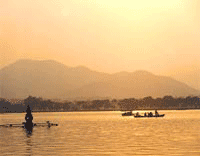 10- West Lake once called "Upper Lake" in the ancient times, which meant that it was a lake in heaven. Over three-quarter of the lake are surrounded by hills, and then is Hangzhou City. This natural beauty scene covers a total area of 5.6 square kilometers, with a perimeter that extends 15 kilometers. Su Causeway and Bai Causeway cut up the lake into five water bodies named respectively Inner Lake, Outer Lake, Yue Lake, West Back Lake, and North Back Lake. "In heaven, there is paradise; on earth, it's Suzhou and Hangzhou". This popular saying captures very well the charm of Hangzhou. Situated in China's eastern province of Zhejiang, Hangzhou was once described by the 13th century Italian traveler Marco Polo as "the most splendid and luxurious city in the world". This is most evident in the West Lake area, the city's most prominent scenic spot. 10- West Lake once called "Upper Lake" in the ancient times, which meant that it was a lake in heaven. Over three-quarter of the lake are surrounded by hills, and then is Hangzhou City. This natural beauty scene covers a total area of 5.6 square kilometers, with a perimeter that extends 15 kilometers. Su Causeway and Bai Causeway cut up the lake into five water bodies named respectively Inner Lake, Outer Lake, Yue Lake, West Back Lake, and North Back Lake. "In heaven, there is paradise; on earth, it's Suzhou and Hangzhou". This popular saying captures very well the charm of Hangzhou. Situated in China's eastern province of Zhejiang, Hangzhou was once described by the 13th century Italian traveler Marco Polo as "the most splendid and luxurious city in the world". This is most evident in the West Lake area, the city's most prominent scenic spot. |
| |
| | >
|
|
 |
|

|
|